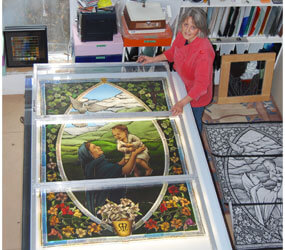WINOOSKI, Vt. – Some people have PowerPoint presentations to illustrate their topics; Monsignor Richard G. Lavalley has windows.
The pastor of St. Francis Xavier Church in Winooski is not referring to anything computer-related but to the dozen and a half stained-glass windows in the church. “I use them all the time. I’m always pointing to the windows” to illustrate a homily, he said.
Stained glass, as an art form, reached its height in the Middle Ages when it became a major pictorial form and was used to illustrate the narratives of the Bible for a mostly illiterate population.
And even though stained-glass windows are not necessary to educate today’s literate and technologically savvy American Catholics, they still play an important role in the life of the church and continue to be created to foster the faith, to inspire and to comfort.
Stained-glass artist Deborah Coombs of Readsboro has created four stained-glass windows for the chapel at St. Henry Church in Nashville, Tenn. Each one is 54 inches by 60 inches and each depicts the life of Jesus and Mary as presented in one of the mysteries of the rosary – joyful, sorrowful, glorious and luminous.
Mosaics of small pieces of glass, the four chapel windows have about 2,500 pieces. They were to be dedicated Jan. 15.
Coombs uses painted and fired colored glass, the same process used for medieval stained glass that has lasted hundreds of years. “It’s very permanent,” she told the Vermont Catholic, the Burlington Diocese’s magazine. “The process is like painting with light.”
“If no light comes through the windows, you don’t see the window,” Monsignor Lavalley said. “Only when the light comes through them are you able to see the beauty of the windows. It’s like the soul without Christ is in darkness.”
Through the penetrating light, color, brightness and images become not just part of the building but are the essence of the building itself, explained Terryl N. Kinder, a visiting professor of fine arts at St. Michael’s College in Colchester.
As the light changes with the time of day, season of the year and weather, the glass reflects these changes. Glass is crystalline in structure, and can make the light passing through it appear different in different circumstances.
Because of the angle of the light and atmospheric conditions at that time of day, in the morning the reds shine more brightly and seem to dominate the windows, while the blues continue to “sing” in the evening long after the other colors have extinguished and are the last to die after the sun sets.
“Stained glass is the quintessential art form of the great Gothic cathedrals of Europe, where the structural advances of ribbed vaults and flying buttresses held up the building without the need for thick walls, which could therefore be opened up to huge expanses of glass,” Kinder said. “In that glass was the story of Christianity.”
Coombs has been making stained glass for more than 30 years. Since coming to the United States from the United Kingdom 15 years ago, most of her work has been religious; most of it back home was secular.
The St. Henry’s committee charged with procuring the chapel windows wanted the rosary to be the basis for them, capturing the essence of each mystery so that each person who enters the chapel will find them helpful for meditation and conducive to prayer.
“We want the windows to speak to them” and give comfort in time of sadness and amplify joy in happy times, said Robert C. Loedding, chairman of the St. Henry Parish finance board and a member of the stained-glass window committee. He noted that taken together, the decades of the rosary offer “the wholeness of the teaching of the church.”
Kinder said people have never been so image-dependent as they are today despite their ability to read and to use the Internet. “Even though we can read, we still love pictures, and seeing how artists at different periods in history have chosen to depict Bible stories and saints’ lives in the stained glass can also shape our own way of imaging or imagining how these stories may have looked,” she said.
Coombs began designing the four chapel windows in 2008 and fabricating them last March.
“Even if no one told you what the windows are about, you should feel the lifting of your spirits as you look from that window (Crucifixion) to that window (Resurrection),” the artist said, gesturing to her drawings for the windows.
She deliberately selected “intense, sad” colors for the sorrowful mysteries – purple, grey, maroon, brown – and light, bright colors for the glorious mysteries – “brilliant, sparkly.”
For the joyful mysteries, she said, she used a lot of uplifting green in the window to make viewers think of new life, springtime and the “fecundity of creation, of nature and of life itself.”


